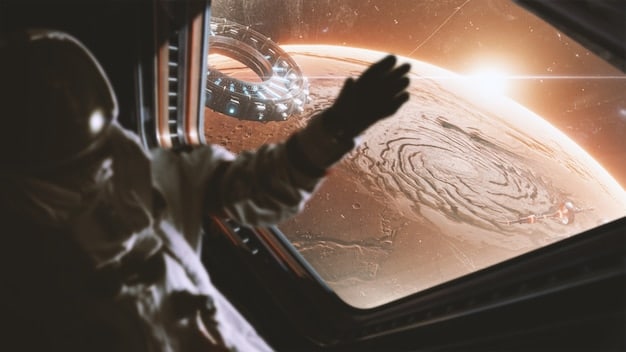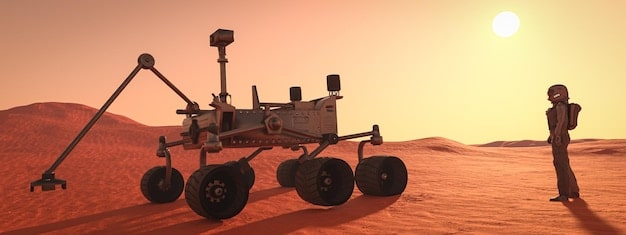NASA’s Next Decade: Lunar and Martian Mission Plans

NASA’s plans for lunar and Martian missions in the next decade involve the Artemis program, aiming to establish a sustainable presence on the Moon, and preparations for future crewed missions to Mars, focusing on technology development and scientific research.
The next decade promises unprecedented advancements in space exploration, with the future of space exploration: what are NASA’s plans for lunar and Martian missions in the next decade? taking center stage.
NASA’s Artemis Program: Returning to the Moon
The Artemis Program is NASA’s flagship initiative, aiming to return humans to the Moon by 2025. This program is not just about repeating the Apollo missions; it’s about establishing a sustainable, long-term presence on the lunar surface to prepare for future missions to Mars.
Artemis I, II, and III: The Stepping Stones
The Artemis program is structured around a series of missions, each with specific objectives. Artemis I was an uncrewed test flight of the Orion spacecraft and the Space Launch System (SLS) rocket. Artemis II will be a crewed flyby of the Moon, and Artemis III aims to land astronauts near the lunar south pole.
The Lunar Gateway: A Space Station in Lunar Orbit
A key component of the Artemis program is the Lunar Gateway, a small space station in lunar orbit. The Gateway will serve as a staging point for lunar landings and a hub for scientific research. It will also provide a platform for testing technologies needed for future Mars missions.
- Sustainability: The Artemis program aims for a sustainable presence on the Moon, unlike the brief Apollo missions.
- Lunar South Pole: Focus on the lunar south pole due to the presence of water ice, a valuable resource for future missions.
- Commercial Partnerships: Collaboration with commercial partners to develop lunar landers and other essential technologies.
The Artemis program represents a significant leap forward in lunar exploration, paving the way for more ambitious missions to Mars and beyond.

Preparing for Mars: Technologies and Research
Beyond the Moon, NASA is actively preparing for future crewed missions to Mars. This involves extensive research and technology development to overcome the challenges of long-duration spaceflight and living on another planet.
Space Launch System (SLS) and Orion Spacecraft
The SLS rocket and Orion spacecraft are critical for future Mars missions. They will provide the necessary power and capabilities to send astronauts on the long journey to Mars and back.
Habitat Development: Living in Space and on Mars
Developing suitable habitats is essential for long-duration missions. NASA is working on advanced habitat designs that can provide a safe and comfortable living environment for astronauts in space and on the Martian surface.
- Radiation Shielding: Developing technologies to protect astronauts from harmful space radiation.
- Closed-Loop Life Support Systems: Creating systems that recycle air, water, and waste to minimize the need for resupply missions.
- In-Situ Resource Utilization (ISRU): Developing technologies to use Martian resources, such as water ice and regolith, to produce fuel, oxygen, and building materials.
These technological advancements are crucial for making Mars missions safer and more sustainable, pushing the boundaries of what is possible in space exploration.
The Search for Life: Mars Sample Return Mission
One of the most exciting aspects of NASA’s Mars exploration program is the search for life. The Mars Sample Return mission aims to collect samples of Martian rocks and soil and bring them back to Earth for detailed analysis.
Perseverance Rover: Collecting Martian Samples
The Perseverance rover is currently exploring the Jezero Crater on Mars, a site believed to have once been a lake. Perseverance is collecting carefully selected samples that could contain evidence of past or present life.
Sample Retrieval Lander: Bringing Samples Back to Earth
The Sample Retrieval Lander will deploy a small rocket to launch the samples into Martian orbit. Another spacecraft will then capture the samples and bring them back to Earth.
Analyzing Martian Samples: Searching for Biosignatures
Scientists on Earth will analyze the returned samples using state-of-the-art equipment, searching for biosignatures that could indicate the presence of life. This mission could provide groundbreaking insights into the possibility of life beyond Earth.
The Mars Sample Return mission represents a significant step in our quest to understand the potential for life on other planets, offering a unique opportunity to study Martian samples in detail.

International Collaboration: Working Together in Space
Space exploration is a global endeavor, and NASA works closely with international partners on many of its missions. International collaboration is essential for sharing resources, expertise, and reducing the costs and risks of space exploration.
European Space Agency (ESA): Key Partner
The European Space Agency (ESA) is a key partner in both the Artemis program and the Mars Sample Return mission. ESA is providing essential hardware and expertise, strengthening the international effort in space exploration.
Japan Aerospace Exploration Agency (JAXA): Contributing to Lunar Missions
The Japan Aerospace Exploration Agency (JAXA) is contributing to lunar missions by providing technology and support for the Artemis program. JAXA’s involvement enhances the capabilities and scope of lunar exploration.
Canadian Space Agency (CSA): Developing Robotics for Space
The Canadian Space Agency (CSA) is developing advanced robotics for use in space, including robotic arms for the Lunar Gateway and other missions. CSA’s contributions are vital for the success of complex space operations.
International collaboration is crucial for advancing space exploration, allowing nations to pool their resources and expertise to achieve ambitious goals.
Challenges and Risks: Overcoming Obstacles in Space
Space exploration is inherently risky, and NASA faces numerous challenges in its lunar and Martian missions. Overcoming these challenges requires innovative solutions, rigorous testing, and careful planning.
Technological Challenges: Developing Advanced Systems
Developing advanced systems that can withstand the harsh conditions of space and operate reliably is a major challenge. This includes developing radiation-hardened electronics, advanced propulsion systems, and autonomous navigation systems.
Health Risks: Protecting Astronauts in Space
Long-duration spaceflight poses significant health risks to astronauts, including exposure to radiation, bone loss, and muscle atrophy. NASA is researching ways to mitigate these risks and protect the health of astronauts on long missions.
Financial Constraints: Balancing Budgets and Priorities
Funding for space exploration is always a challenge, and NASA must balance its budget and priorities to ensure that its missions can be accomplished within available resources. This requires careful planning, efficient management, and strong public support.
Addressing these challenges is essential for ensuring the safety and success of NASA’s lunar and Martian missions, pushing the boundaries of what is possible in space exploration.
The Future Beyond Mars: Long-Term Goals
While lunar and Martian missions are the focus for the next decade, NASA also has long-term goals that extend beyond Mars. These goals include exploring the outer solar system, searching for exoplanets, and developing technologies for interstellar travel.
Europa Clipper: Exploring Jupiter’s Moon
The Europa Clipper mission will explore Jupiter’s moon Europa, which is believed to have a subsurface ocean that could potentially harbor life. This mission will provide valuable insights into the potential for life in the outer solar system.
Nancy Grace Roman Space Telescope: Searching for Exoplanets
The Nancy Grace Roman Space Telescope will search for exoplanets, planets orbiting other stars. This telescope will provide a wide field of view and the ability to detect faint signals from distant planets, expanding our understanding of planetary systems beyond our own.
Developing Technologies for Interstellar Travel
Although interstellar travel is still far in the future, NASA is investigating advanced propulsion systems and other technologies that could one day make it possible. This includes research into fusion propulsion, advanced materials, and autonomous spacecraft.
These long-term goals represent a vision for the future of space exploration, pushing the boundaries of human knowledge and capability.
| Key Point | Brief Description |
|---|---|
| 🚀 Artemis Program | Returning humans to the Moon by 2025. |
| 🧪 Mars Sample Return | Collecting Martian samples for analysis on Earth. |
| 🤝 International Collaboration | Working with ESA, JAXA, and CSA on space missions. |
| 🔭 Europa Clipper | Exploring Jupiter’s moon, Europa, for potential life. |
Frequently Asked Questions
▼
The main goal of the Artemis program is to establish a sustainable presence on the Moon and use it as a stepping stone for future missions to Mars.
▼
The Lunar Gateway is a space station in lunar orbit that will serve as a staging point for lunar landings and a hub for scientific research.
▼
The Mars Sample Return mission aims to collect samples of Martian rocks and soil and bring them back to Earth for detailed analysis to search for signs of life.
▼
NASA is collaborating with the European Space Agency (ESA), the Japan Aerospace Exploration Agency (JAXA), and the Canadian Space Agency (CSA) on various space missions.
▼
Some of the main challenges include developing advanced technologies, protecting astronauts from health risks in space, and managing financial constraints.
Conclusion
NASA’s plans for the next decade are ambitious and far-reaching, encompassing lunar missions through the Artemis program and preparations for eventual crewed missions to Mars. Through technological advancements, international collaborations, and overcoming significant challenges, NASA is poised to advance our understanding of the universe and pave the way for future human exploration beyond Earth.





